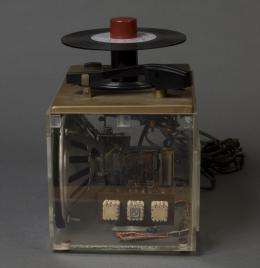Crowdsourcing Science History: NIST digital archives seeks help in identifying mystery artifacts

Do you hold the key to solving some gadget mysteries from the last century of U.S. science and technology? In its 110 years, the National Institute of Standards and Technology (NIST) has made many innovations in the way we measure things, from basic quantities like the volt and nanometer to specialized questions like the purity of sugar.
A new website, the NIST Digital Archives (nistdigitalarchives.contentdm.oclc.org/), is exhibiting images of historically significant scientific instruments used to obtain these measures, in addition to providing access to full-text publications from the agency's history. (To end the suspense, you measure sugar with a saccharimeter.) NIST is inviting enthusiasts to participate in describing some of the hundreds of historical objects collected through the decades. Some of the artifacts are unidentified or need more descriptive information. Visitors to the site can view the items and offer clues about the history and origins of some of these important artifacts.
The artifacts are in the collection of scientific instruments in the NIST Museum, located on the NIST campus in Gaithersburg, Md., and can be viewed on the NIST Museum Artifacts portion of the new Website. Most of the artifacts are well-documented, such as a 1950s creation known as the Project Tinkertoy Wafer Tube Amplifier. It is a 45 rpm record player built as a part of Project Tinkertoy, an endeavor to develop mechanical production methods for electronic equipment using standardized components. However, some artifacts remain a mystery, such as the enigmatic brass-colored, crank-like Metal Instrument in Wood Case.
"We have some artifacts in our collection we want to identify, so we thought we could exhibit them online and ask for help," says NIST Digital Services Librarian Regina Avila. "It was fun to photograph them, but challenging. Some artifacts were broken, others had missing pieces. Some were heavy and others were fragile." Currently, 137 artifacts are on the site, and hundreds more will be added in the coming months.
.jpg)
The digital archive also contains some NIST publications, including the Journal of Research of the National Institute of Standards and Technology, which covers the broad range of research undertaken by NIST research staff, focusing on measurement methodology. Visitors can access full-text papers from the journal dating from 1981 to the present. Pre-1981 papers are being added to the collection on an ongoing basis with the goal of making available all papers back to 1904.
NIST's Information Services Office (ISO), which has won several awards including Federal Library of the Year in 2003 and 2008, is responsible for creating, maintaining and disseminating NIST's knowledge base, including its history. The NIST Digital Archives is part of the ISO's Museum and History Program, which collects, conserves and exhibits significant NIST artifacts and records to provide institutional memory and demonstrate NIST's contributions to the development of standards, technology and science. This digital archive is the realization of an effort to provide better access to our historical assets. "We were looking for a mechanism for making the information about NIST's scientific contributions more widely available to the public," says Barbara Silcox, the NIST Program Manager for Digital Information Services. Future collections in the NIST Digital Archives will include images of historical photographs from NIST, items from the NIST Oral History collection and video recordings of selected NIST Colloquia.
Provided by National Institute of Standards and Technology










.jpg)






